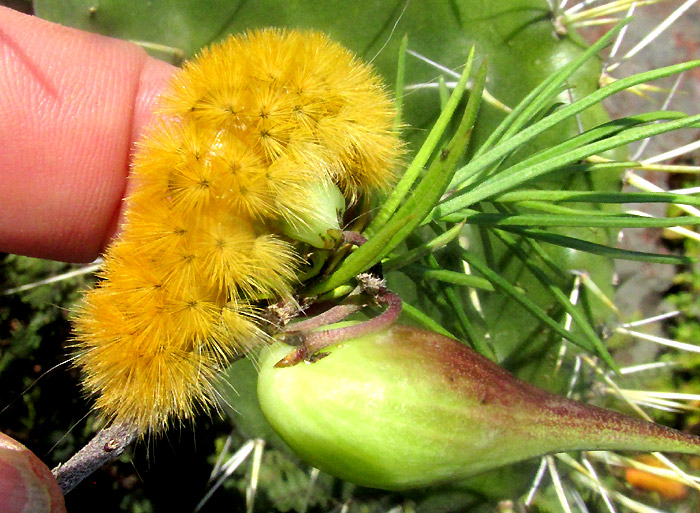Excerpts from Jim Conrad's
Naturalist Newsletter
Entry dated November 7, 2023, from notes taken at Cascadas de La Piedad waterfall 3kms NW of the community of San Pablo, municipality of Almeaco de Bonfil; bedrock of igneous andesite; N20.1008°, W100.0041°, elevation 2360 meters (7750ft); extreme southern Querétaro state, MÉXICO
LERINA INCARNATA CATERPILLAR ON ASCLEPIAS LINARIA

In thin soil atop pinkish, igneous andesite rock at the edge of the canyon formed a little downstream from the Cascada de La Piedad, or Piety Waterfall, the above caterpillar perched unmoving atop a knee-high, fruiting Asclepias linaria. Knowing how difficult it is to identify caterpillars where no illustrated field guides are available, usually I pass by them. However, this time, two features of what's seen above suggested that this one might be easier to identify.
First, the caterpillar's size and hairiness was similar to a species very common where I grew up in Kentucky in the US. We called them "woolly worms," but in books usually they were referred to as woolly bears, banded woolly bears, or the caterpillars of the Isabella Tiger Moth, Pyrrharactia isabella. Maybe on the Internet mention could be found of species closely related to Kentucky woolly worms, appearing in this part of highland central Mexico.
Secondly, the plant on which the caterpillar evidently had been feeding was Asclepias linaria, the Pineneedle Milkweed; it grew abundantly thereabouts. This was interesting because milkweeds contain chemical toxins known as cardenolides, which prevent most animals from eating them. However, caterpillars of the famous Monarch butterflies, Danaus plexippus, feed on them -- actually need them -- for the milkweed's toxins accumulate in the caterpillar's body, and later are retained in the butterfly's body, which discourages predators from eating both the caterpillars and butterflies. In fact, the 2015 study by Gail Morris and others entitled "Status of Danaus plexippus in Arizona," lists Pineneedle Milkweed as a host for Monarch Butterfly caterpillars. Since few caterpillar species other than those of Monarchs feed on milkweeds, maybe that would help during the identification process.
In case it also would help with identification, a close-up of hair tufts was taken:

My childhood woolly worms, Pyrrharactia isabella, belonged to the large moth family Erebidea. On the GBIF.Org world map displaying georeferenced records of Erebedae species, I zoomed in on our part of highland central Mexico and clicked on the "explore area" link. This brought forth a list of maybe a hundred documented observations of around 20 different species seen in our area. Searching for images of each listed species, eventually matching pictures popped up, identified as Lerina incarnata.
However, there might be more than one fuzzy, yellowish caterpillar in our area, so now I searched for web pages associating Lerina incarnata with Asclepias species. The Bugguide.Com page for Lerina incarnata resulted, where the only food listed for the species was the Pineneedle Milkweed -- exactly the plant on which our caterpillar was perched.
Therefore, I'm confident in calling our caterpillar LERINA INCARNATA, whose adult moth form is known as the Crimson-bodied Lichen Moth. Crimson-bodied Lichen Moths are distributed from arid southeastern Arizona in the US south through the uplands of Mexico to about Oaxaca.
Apparently Lerina incarnata is an unusual moth, for it's the only species assigned to the genus Lerina.
However, this appears to be one of those species which appears on numerous lists, and is photographed fairly frequently, but about which hardly anything is known, other than its caterpillars feed on Pineneedle Milkweed.